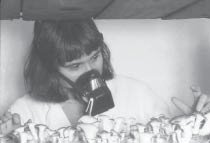Common Problems Faced by Oyster Mushroom Growers
Pests Bacteria.
Bacteria. The most common bacterial problem encountered by growers is Pseudomonas tolaasii. This is the same bacterium that causes bacterial blotch of A. bisporus. Symptoms of the disease include reduced yield and orange discoloration and brittleness of the basidiocarps (Figure 9). Infected mushrooms have a reduced shelf life. Constant and high RH, insufficient air movement, overheating of the substrate (above 35°C), excessive moisture content, and especially a wet mushroom surface may exacerbate P. tolaasii infection. Lowering RH to 80 to 85 percent, and sprinkling the surface of the bags between flushes with 0.2 percent bleach solution may help maintain control.

Figure 9. Mushrooms emerging from pasteurized substrate contained in black plastic bags
showing symptoms of bacterial blotch caused by Pseudomonas tolaasii.
Symptoms of mushrooms produced on substrate infested with P. tolaasii
include orange discoloration, brittleness, reduced shelf life, and reduced yield.
Fungi. Most fungi encountered in oyster mushroom production grow and develop on the substrate and are very rarely parasitic. The most frequently encountered genera include Aspergillus, Botrytis, Coprinus, Fusarium, Monilia, Mucor, Penicillium, Trichoderma, and Trichothecium. Substrates that have only been pasteurized are more susceptible to infestation than substrates that have been pasteurized and conditioned. Fungal infestation may be more of a problem when substrates are supplemented with nitrogen-rich nutrients — especially if the supplements are not commercial delayed-release nutrients. Infesting fungi may also be more of a problem when substrate temperatures rise above 35°C. Higher substrate temperatures may injure mushroom spawn, reduce mycelial growth rates, and leave the substrate vulnerable to competitors such as Coprinus spp. (ink caps) and Trichoderma spp. (green mold).
Fungi of the genera Cladobotryum and Verticillium, known to cause disease of A. bisporus, are rarely encountered in Pleurotus spp. cultivation. These fungi, when they are encountered in oyster mushroom production, may be found mainly on aged basidiocarp and stipe residues.
Insects. Insects infesting mushroom tissues cause the greatest losses for growers, particularly during summer months. The most important insect pests associated with oyster mushroom tissue include Cecidomyiidae (Mycophila speyeri), Scatopsidae, Sciaridae (Lycoriella solani), and Phoridae (Megaselia halterata, M. nigra). Oyster mushroom primordia are very sensitive to chemical vapors, so using pesticide to control insects is difficult. Large clusters of deformed oyster mushroom tissue resembling «cauliflower» have been observed after insecticides were applied during primordial formation. Use of various flytraps and adherence to strict hygiene practices, particularly during spawning and spawn run, help keep fly populations below economic threshold levels. In the United States, Bacillus thuringiensis var. israeliensis (Bti), when incorporated into the substrate at spawning, has shown excellent effectiveness against sciarid flies.
Deformed Fruit Bodies
Deformed mushrooms may result from several causes, many of them still unknown. However, most deformed mushrooms may be traced to insufficient ventilation, smoke, chemical vapors, overheated substrate during spawn run, extreme low fruiting temperature (below 10°C), and insufficient light.
Airborne Spores
Spore production. A single mushroom may produce up to 4 million spores per hour. Worker exposure to airborne spores is a concern on most farms. Inhaled spores can cause an allergic reaction in some workers. In the United States, masks are worn to filter out spores released from the maturing mushrooms (Figure 10). Exposure can be minimized by introducing higher volumes of fresh air 1 to 2 hours before harvesting and by wearing a proper mask.

Figure 10. Pickers should wear masks to reduce exposure to airborne mushroom spores.
Inhalation of spores may cause flu-like symptoms among sensitized workers.
19159 view.